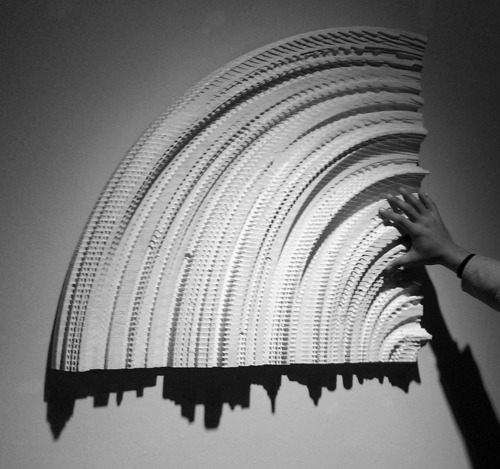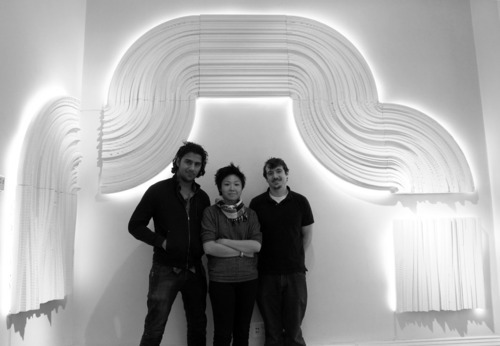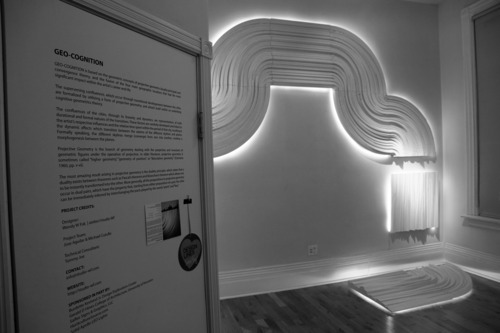
GEO-COGNITION
(2012)
(2012)
*Note: Shadows produce Cityscape
GEO-COGNITION is based on the geometric concepts of projective geometry (duality principal) and the convergence theory, and the fusion of the four main geographic locations that had the most significant impact within the artist’s career and life.
The supervening confluences, which occur through transitional developments between the cities, are formalized by utilizing a form of projective geometry, and attach itself within an underlying cognitive geometrics theory.
The confluences of the cities, through its linearity and dynamics, are representations of both durational and formal natures of the transitions. These factors are carefully developed and linked to the artist’s respective influences and the relative time spent within the period of that city, resulting in the dynamic affects which transition between the axioms of the different skylines and planes. Formally speaking, the different skylines merge (converge) from one into another, creating a morphogenesis between the planes.
Projective Geometry is the branch of geometry dealing with the properties and invariants of geometric figures under projection. In older literature, projective geometry is sometimes called “higher geometry,” “geometry of position,” or “descriptive geometry” (Cremona 1960, pp. v-vi).
The most amazing result arising in projective geometry is the duality principle, which states that a duality exists between theorems such as Pascal’s theorem and Brianchon’s theorem which allows one to be instantly transformed into the other.
More generally, all the propositions in projective geometry occur in dual pairs, which have the property that, starting from either proposition of a pair, the other can be immediately inferred by interchanging the parts played by the words “point” and “line.”
MATERIAL EXPLORATION:
The material exploration of GEO-COGNITION was made possible by utilising the byproduct of an architectural construction site. Fact shows that most US construction sites and construction managers overstock on more than 30% of building materials for construction.
Over 70 million tonnes (155 000 million pounds) of waste is produced in the construction industry each year. This amounts to 55 LBS per week for every person, about four times the rate of household waste production.
The EPS DOW insulation foam used to CNC mill, produce, and fabricate GEO-COGNITION was made possible through donations from an actual construction site (a commercial building on the campus of the University of Houston), whereby the site manager offered us to take the overstocked material.
Through reusing the overstocked insulation material, it provided us (the artist) complimentary materials for production, while also lessening the waste creation and dumping cost for the contractor. This type of cradle to cradle/grave approach to design allows an innovation of creation, and amalgamation between art and architecture.
Different material explorations, including the use of HIPS and MDF, and several prototypes were made before finalising on the EPS DOW insulation.
PROJECT CREDITS:
AWARDS:
Design Lines - Love Tags (1 of 100 selected best designs from Toronto Design Week)
PUBLISHED:
DesignLines Magazine
AZURE Magazine
CBC Television
ART Toronto Television
Trend Hunter
SPONSORED IN PART BY:
Burdette Keeland Jr. Design Exploration Center
Gerald D Hines College of Architecture, University of Houston
Saifee Signs & Graphics, LLC
Solid Apollo LED Lights
GEO-COGNITION is based on the geometric concepts of projective geometry (duality principal) and the convergence theory, and the fusion of the four main geographic locations that had the most significant impact within the artist’s career and life.
The supervening confluences, which occur through transitional developments between the cities, are formalized by utilizing a form of projective geometry, and attach itself within an underlying cognitive geometrics theory.
The confluences of the cities, through its linearity and dynamics, are representations of both durational and formal natures of the transitions. These factors are carefully developed and linked to the artist’s respective influences and the relative time spent within the period of that city, resulting in the dynamic affects which transition between the axioms of the different skylines and planes. Formally speaking, the different skylines merge (converge) from one into another, creating a morphogenesis between the planes.
Projective Geometry is the branch of geometry dealing with the properties and invariants of geometric figures under projection. In older literature, projective geometry is sometimes called “higher geometry,” “geometry of position,” or “descriptive geometry” (Cremona 1960, pp. v-vi).
The most amazing result arising in projective geometry is the duality principle, which states that a duality exists between theorems such as Pascal’s theorem and Brianchon’s theorem which allows one to be instantly transformed into the other.
More generally, all the propositions in projective geometry occur in dual pairs, which have the property that, starting from either proposition of a pair, the other can be immediately inferred by interchanging the parts played by the words “point” and “line.”
MATERIAL EXPLORATION:
The material exploration of GEO-COGNITION was made possible by utilising the byproduct of an architectural construction site. Fact shows that most US construction sites and construction managers overstock on more than 30% of building materials for construction.
Over 70 million tonnes (155 000 million pounds) of waste is produced in the construction industry each year. This amounts to 55 LBS per week for every person, about four times the rate of household waste production.
The EPS DOW insulation foam used to CNC mill, produce, and fabricate GEO-COGNITION was made possible through donations from an actual construction site (a commercial building on the campus of the University of Houston), whereby the site manager offered us to take the overstocked material.
Through reusing the overstocked insulation material, it provided us (the artist) complimentary materials for production, while also lessening the waste creation and dumping cost for the contractor. This type of cradle to cradle/grave approach to design allows an innovation of creation, and amalgamation between art and architecture.
Different material explorations, including the use of HIPS and MDF, and several prototypes were made before finalising on the EPS DOW insulation.
PROJECT CREDITS:
Designer:
Wendy W Fok | atelier//studio WF
Project Team:
Jose Aguilar & Michael Cutulle
Technical Consultant:
Tommy Joe
CONTACT:
info@studio-wf.com
WEBSITE:
http://studio-wf.com
EXHIBITED:
Come Up To My Room 2012
Toronto Design Week - Offiste
the Gladstone Hotel, Toronto, Canada
FIGMENT - Groundbreaking 2012 (Auction)
Wendy W Fok | atelier//studio WF
Project Team:
Jose Aguilar & Michael Cutulle
Technical Consultant:
Tommy Joe
CONTACT:
info@studio-wf.com
WEBSITE:
http://studio-wf.com
EXHIBITED:
Come Up To My Room 2012
Toronto Design Week - Offiste
the Gladstone Hotel, Toronto, Canada
FIGMENT - Groundbreaking 2012 (Auction)
AWARDS:
Design Lines - Love Tags (1 of 100 selected best designs from Toronto Design Week)
PUBLISHED:
DesignLines Magazine
AZURE Magazine
CBC Television
ART Toronto Television
Trend Hunter
SPONSORED IN PART BY:
Burdette Keeland Jr. Design Exploration Center
Gerald D Hines College of Architecture, University of Houston
Saifee Signs & Graphics, LLC
Solid Apollo LED Lights







